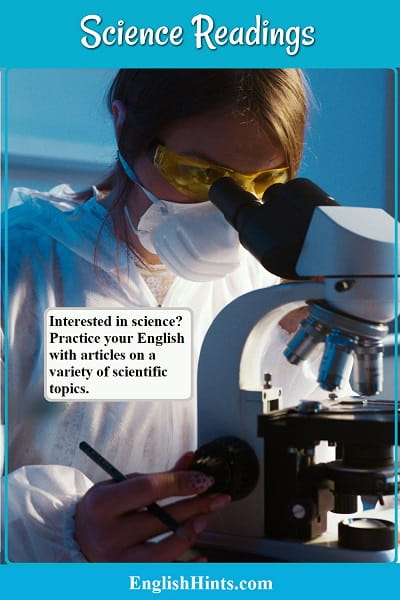Science Readings to Practice English
Use these science readings to practice English-- and look at a variety of fields of scientific research.
The science readings linked from this page were first featured in English Detective, EnglishHint's semi-weekly newsletter.
I look for (mostly) brief, interesting articles to help you practice English on one subject at a time.
You can learn or review relevant vocabulary in context while getting different perspectives on topics that matter. (They matter to me, anyway-- and I believe you'll find some that resonate with you, too.)
Two Virus-Fighting Heroines
Two stories on fighting disease that have stood out to me recently both had unlikely heroines. These very different women resisted the strong pressures of society and scientific consensus—and ended up saving uncounted lives.
Lady Mary Wortley Montagu learned the technique of smallpox inoculation from the female healers of the Ottoman Empire when her husband was an English ambassador there. (It seems that male doctors there did not use it.)
In 1721, soon after she had returned to England, a smallpox epidemic broke out. Lady Montague had her daughter inoculated and urged others to do so as well, in spite of opposition from the English medical establishment and others.
She wrote, "I am patriot enough to take the pains to bring this useful invention into fashion in England." As the NPR article points out in fascinating detail, her efforts led to thousands of lives saved. One of those inoculated was Edward Jenner, who would later develop the (safer) smallpox vaccine.
The second article (and podcast) describes how Katalin Karikó and other scientists continued to study mRNA even when it meant risking funding, university backing, and (for Karikó, an immigrant from Hungary) deportation.
It took years of hard work, and a constant struggle for funding, before their research paid off. Now, as the article’s title mentions, “if covid-19 vaccines bring an end to the pandemic, America has immigrants to thank.” Without their stubborn belief in the value of their work, we would not have the Moderna or Pfizer vaccines.
Do we need a new “Green Revolution?”
Have you heard of the “Green Revolution?” After World War 2, plant breeders developed much more productive varieties of wheat and rice. They enabled countries like Mexico and India to go from importing those staples to growing enough for their own use and to sell to other countries.
Norman Borlaug, the plant breeder that started it, won the Nobel prize in 1970 for helping to prevent the mass famine that many people had feared as populations increased after the war.
Then the criticism began, and grew. People began to see that it caused water pollution and other environmental damage as well as harm to traditional ways of life.
Over time there were also questions of motive. Were western countries just pushing their own solutions and technologies, and maybe more interested in preventing communism from taking hold than in the needs of local people?
The Green Revolution’s emphasis on a few very productive grain varieties has led to a major decrease in crop diversity, replacing many more nutritious crops with large fields of a single kind of wheat or rice.
Large farming operations have put poor farmers at even more of a disadvantage, since they cannot afford the fertilizer or irrigation techniques it requires.
PBS conducted three interviews with experts from different countries and perspectives on the good and bad effects of the Green Revolution, looking back on it half a century later.
All three articles are interesting, but I’d recommend the third (unless you have time to skim all three.) The first two emphasize the historical context a little more. (#1 gives more background on Borlaug, & #2 on the Cold War context.
The 3rd interview discusses the tragic irony of good intentions that had unforeseen consequences. It tells how Borlaug’s work to make wheat more disease-resilient ended up making farming much less resilient (unable to deal with problems that arise.)
The interview finishes with the hope that farmers can learn from each other and make changes for a better future.
National Geographic also has a fascinating (though long) article on current research—a “next green revolution”—that researchers hope will be more environmentally friendly and sensitive to the needs of small farmers and their communities.
If you can take a few minutes to skim the first two sections and look through the pictures and diagrams, you can get a good background picture.
It starts with the increasing risks of crop failure in East Africa—specifically of cassava, now being attacked by disease-carrying whiteflies that are becoming much more common as the climate warms.
Then there’s a short, mostly positive discussion of how the Green Revolution prevented famine in the last century. “From the 1960s through the 1990s, yields of rice and wheat in Asia doubled. Even as the continent’s population increased by 60 percent, grain prices fell, the average Asian consumed nearly a third more calories, and the poverty rate was cut in half.”
The rest of the article goes into detail about competing visions for that new green revolution, using controversial genetically modified (GM) plants or other new breeding techniques and more ecologically friendly methods that show promise.
There’s a long discussion of more versatile rice crops being bred in the Philippines to solve various environmental problems.
The article also talks about E. African organic farming experiments with a more diverse set of crops as one alternative to crop failures (and also to farmer debt.)
The article’s conclusion: “It’s not choosing one type of knowledge—low-tech versus high-tech, organic versus GM—once and for all. There’s more than one way to increase yields or to stop a whitefly.” It sees hope as people apply new ecological and cultural understanding along with high-tech advances
A Scientific Cliffhanger*
If a science reading about research can be a “cliffhanger,”* this is it. It describes a scientist’s desperate search to find a cure for his father’s mysterious muscle-wasting disease. Suspecting its genetic basis, he was working to save himself and his brother as well.
This New York Times’ article describes Dr. Sharif Tabebordbar’s research into treatments for muscular diseases. These diseases have been difficult to treat, since the disabled viruses that can deliver the therapy are toxic to the liver in the quantities needed to treat muscles.
After long trials with different viruses, Dr. Tabebordbar finally found some that target muscles directly, mainly bypassing the liver. The research has opened doors to less toxic treatments for a range of muscular diseases.
This is a long article, but well worth reading—for the story as well as for a glimpse of possible breakthroughs in gene therapy. It highlights the tremendous determination, patience, and painstaking work that makes them possible.
(As always, it also is great English practice.)
If you can't access the New York Times article, see it in the Seattle Times.
If you just want a quick read with the takeaways of the value of the research, the first 401 words works as a summary.
*Cultural side note: A "cliffhanger" is a story in which the hero goes from one extremely dangerous situation to another. It’s as if he or she is barely hanging onto the edge of a cliff, in constant danger of falling and dying.
Authors and screenwriters plan chapter breaks and commercials to come at the peak of tension so readers and viewers won’t leave. Cliffhangers are usually found in fiction—especially superhero, adventure, or spy stories
More Science Readings
Why science communication matters
We’ve lost precious time to limit climate change while many Americans questioned whether people caused it or not.
In 2020 we lost precious time to control Covid-19 when it first started spreading around the world. Misinformation and misunderstanding of exponential growth slowed decision-making during the crucial first weeks.
Scientists and health professionals understood and tried to sound the alarm. Korea, Singapore, and Taiwan understood (after previous experience with other coronaviruses). They saved many lives with their decisive actions.
To me, it underscores why the general public needs to understand how science works, what we know, and why it matters. It isn’t easy, since there are people promoting misinformation and fake ‘news.’
I found several useful articles that discuss ways to communicate science more effectively. They’re all linked from the Communicating Science page on EnglishHints. I hope you find them as thought-provoking as I have!
Home > Reading Articles to Improve Your English > Science Readings
Didn't find what you
needed? Explain what you want in the search box below.
(For example, cognates, past tense practice, or 'get along with.') Click to see the related pages on EnglishHints.
| site search by freefind | advanced |






